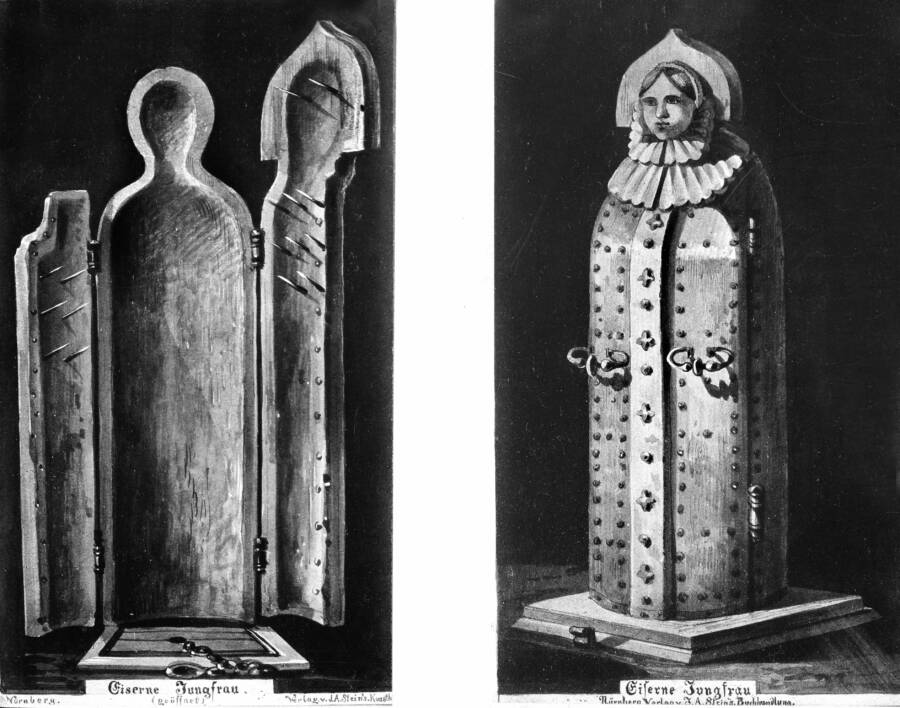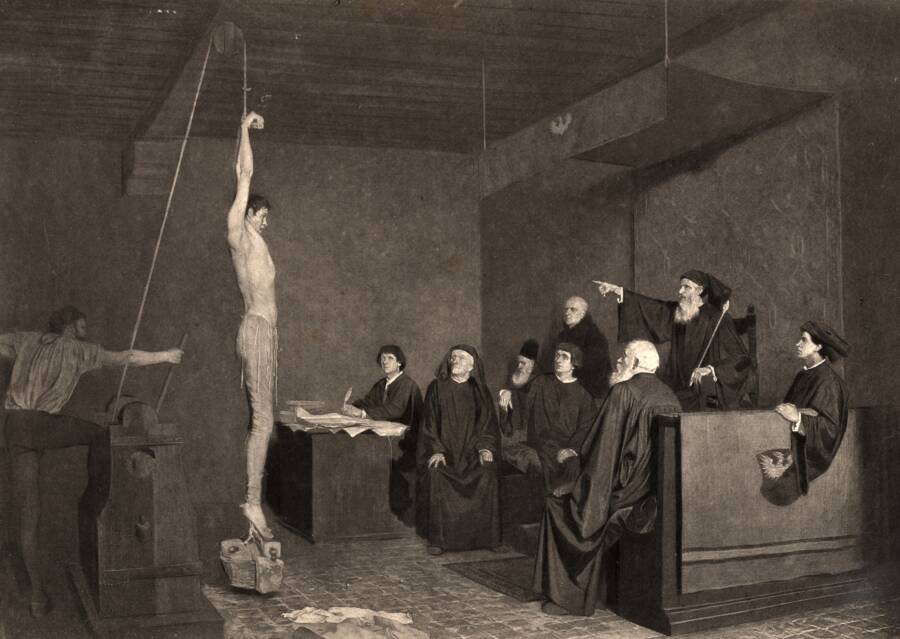The Iron Maiden remains one of the most notorious torture contraptions of all time, but contrary to popular belief, it was never actually used in the Middle Ages at all.

The Print Collector/Getty ImagesA woodcut print of an Iron Maiden being used in a torture room.
The Iron Maiden is perhaps one of the most recognizable medieval torture devices of all time, thanks in large part to its prominence in films, television shows, and cartoons like Scooby-Doo. As far as torture devices go, though, the Iron Maiden is really quite simple.
It is a human-shaped box, decorated on the inside with incredibly sharp spikes that would, presumably, impale through the victim on either side when the box was shut. But the spikes were not long enough to kill a person outright — rather, they were short and placed in such a way that the victim would die a slow and agonizing death, bleeding out over time.
At least, that was the idea. Except, the Iron Maiden wasn’t a medieval torture device at all.
The first written reference to the Iron Maiden didn’t appear until the late 1700s, long after the Middle Ages had come to an end. And while torture most certainly existed during the Middle Ages, many historians have argued that medieval torture was much simpler than later accounts would imply.
Many Medieval Torture Devices Weren’t Actually Medieval
There’s a widely-held notion that the Middle Ages were an uncivilized time in history.
The collapse of the Holy Roman Empire led to a sharp decline in technical capacity and material culture as the infrastructure that the Romans had installed came to a near-total collapse. Suddenly, Europeans could no longer rely on the mass production of Roman factories and on Rome’s complex commerce systems.
Instead, everything became smaller in scale. Pottery was rough and homemade. Luxury goods were no longer traded over long distances. This is why the Middle Ages were often referred to as the “Dark Ages” by certain scholars — it seemed as if everything was in a state of decline.

Hulton Archive/Getty ImagesMedieval farmers working the fields and sowing seeds.
Basically, starting in the 14th century, some Italian scholars viewed the history of the world in three distinct phases: the Classical Age, when the ancient Greeks and Romans were at the height of wisdom and power; the Renaissance, the age in which these scholars lived and things were generally on the up and up; and everything in between, the Middle Ages.
As British historian Janet Nelson explained in the History Workshop Journal, these writers believed “theirs was a time of reborn classical culture, they rescued Greek from near-oblivion, removed errors from Latin, cleared fog from philosophy, crassness from theology, crudeness from art.”
Therefore, all of those pesky years between the Classical Age and the Renaissance were deemed an uncivilized, barbaric time in history — and so many torture devices that were used much later or much earlier became associated with the Middle Ages.
The First Mention Of The Iron Maiden
As Medieval Warfare magazine editor Peter Konieczny wrote for medievalists.net, many “medieval” torture devices weren’t medieval at all, including the Iron Maiden.
The first mention of the Iron Maiden actually came from 18th-century writer Johann Philipp Siebenkees, who described the device in a guidebook to the city of Nuremberg.
In it, he wrote of a 1515 execution in Nuremberg in which a criminal was allegedly placed in a device reminiscent of a sarcophagus lined on the inside with sharp spikes.
The man was shoved into the device and executed “slowly,” Siebenkees wrote, “so that the very sharp points penetrated his arms, and his legs in several places, and his belly and chest, and his bladder and the root of his member, and his eyes, and his shoulder, and his buttocks, but not enough to kill him, and so he remained making great cry and lament for two days, after which he died.”

Roger Viollet via Getty ImagesThe Iron Maiden of Nuremberg.
But many scholars believe Siebenkees may have invented this story, and that the Iron Maiden didn’t exist before the 18th century at all.
The Iron Maiden Myth Spreads
Not long after Siebenkees published his account, Iron Maidens began to appear in museums across Europe and the United States, pieced together using various medieval artifacts and scraps and put on display for those willing to pay a fee. One even appeared in the 1893 World’s Fair in Chicago.
Perhaps the most famous of these devices was the Iron Maiden of Nuremberg, which wasn’t constructed until the early 19th century and was later destroyed in a bombing by Allied forces in 1944. The Iron Maiden of Nuremberg was eventually deemed a fake, yet some have claimed that it was used as early as the 12th century.
In one horrifying account, an Iron Maiden was found at the site of the Iraqi National Olympic committee in Baghdad in 2003. TIME reported that at one time Uday Hussein, the son of Saddam Hussein, headed both the Olympic committee and the country’s soccer federation, and it’s believed he may have used the Iron Maiden to torture athletes who didn’t perform well.
Konieczny identified several other torture devices that have incorrectly been attributed to the Middle Ages. The Brazen Bull, for example, is often believed to be a medieval invention, yet its creation can reportedly be traced to the 6th century B.C.E.
The Pear of Anguish was likewise associated with the Middle Ages, but records of devices like it don’t appear until the mid-19th century. So, too, did The Rack become synonymous with medieval times, though it was much more common in antiquity, and only one more recent example of it can be traced to the Tower of London in 1447.
In reality, torture in the Middle Ages involved much less complex methods.
What Was Torture In The Middle Ages Really Like?
Most of these myths about torture in the Middle Ages were spread by people living in the 18th and 19th centuries, Konieczny explained.
“You get that idea that people were much more savage in the Middle Ages, because they want to see themselves as less savage,” Konieczny told Live Science. “It’s so much easier to pick on people who have been dead for 500 years.”
In essence, Konieczny believes that people in the 1700s and 1800s exaggerated a bit when it came to their accounts of the Middle Ages. In the years since, that exaggeration has compounded, and now many of these 18th-century myths are viewed as fact.
For example, the argument has been made in recent years that the flail, a ball-and-chain weapon commonly associated with the medieval era, wasn’t used during the Middle Ages at all, despite what most people think.
In fact, the flail was only historically featured in epic artworks depicting fantastical battles, but it never showed up in any medieval armory’s catalog. The flail, much like the Iron Maiden, seems to have become linked to a specific time in history due to the influence of storytelling by later historians.

Rischgitz/Getty ImagesA 15th-century tribunal with an accused man being tortured in front of the members of the court in order to extract a confession.
That’s not to say torture didn’t exist during that time, however.
“There was an idea in the Middle Ages that you were really honest when you were under a lot of punishment, under a lot of strain,” Konieczny said. “That the truth comes out when it starts to hurt.”
There were much simpler ways of extracting this information, though — ones that didn’t involve a litany of elaborate devices.
“The more common torture was to just kind of bind people up with rope,” Konieczny said.
So, there you have it. There have certainly been execution methods used in the past that resembled the Iron Maiden — the idea of a box with spikes inside isn’t particularly revolutionary — but the Iron Maiden itself seems to be more fiction than fact.
After reading about the Iron Maiden, learn all about The Rack, the torture device that stretched out its victim’s limbs until they dislocated. Then, read about the Spanish Donkey, the brutal torture device that mangled its victim’s genitalia.





